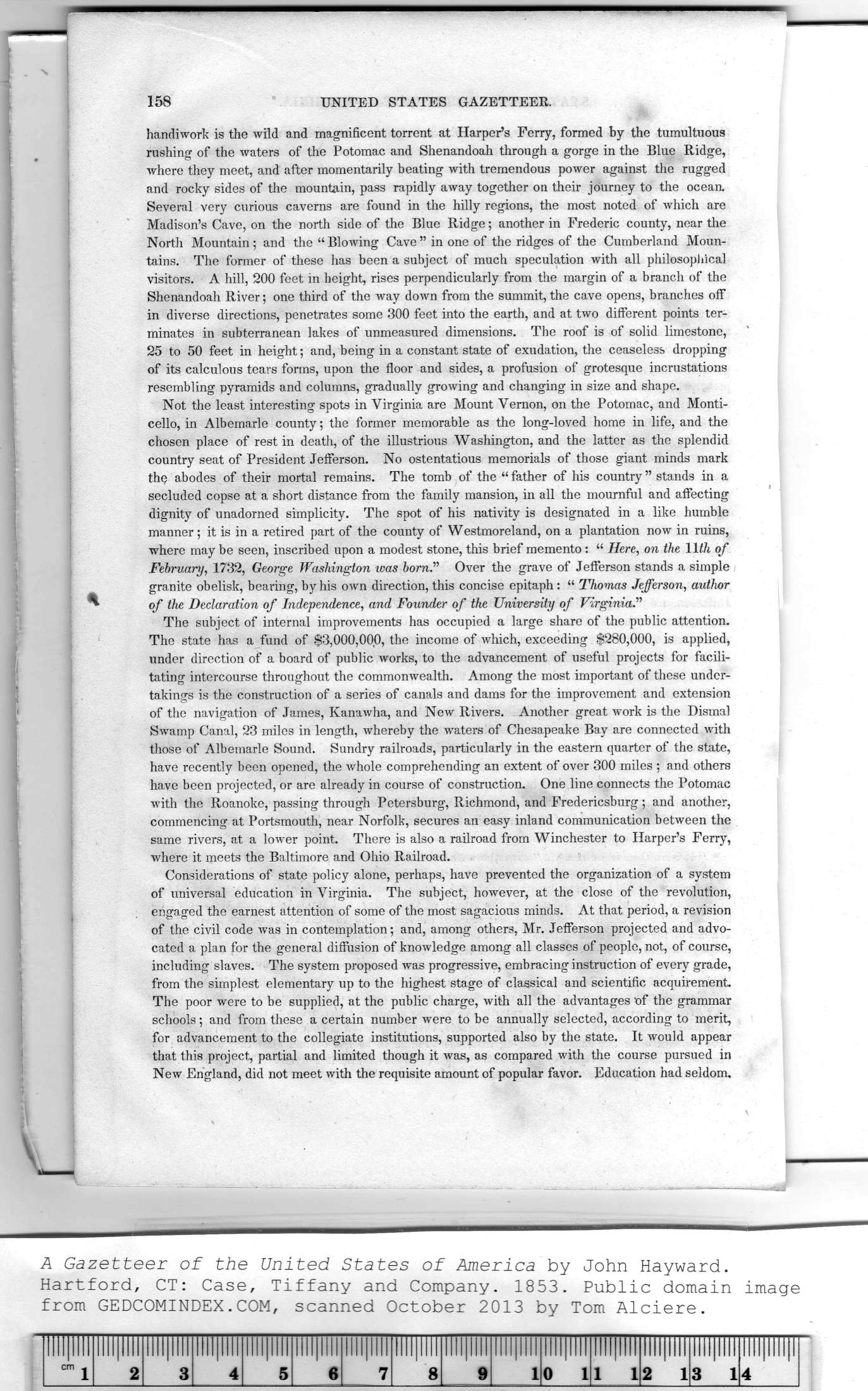|
|
Note: Ctrl and + increases the font size of the text below, Ctrl and - decreases it, and Ctrl and 0 resets it to default size.
158 UNITED STATES GAZETTEER.
handiwork is the wild and magnificent torrent at Harper's Ferry, formed by the tumultuous
rushing of the waters of the Potomac and Shenandoah through a gorge in the Blue Ridge,
where they meet, and after momentarily beating with tremendous power against the rugged
and rocky sides of the mountain, pass rapidly away together on their journey to the oceaa
Several very curious caverns are found in the hilly regions, the most noted of which are
Madison's Cave, on the north side of the Blue Ridge; another in Frederic county, near the
North Mountain; and the “Blowing Cave" in one of the ridges of the Cumberland Moun-
tains. The former of these has been a subject of much speculation with all philosophical
visitors. A hill, 200 feet in height, rises perpendicularly from the margin of a branch of the
Shenandoah River; one third of the way down from the summit, the cave opens, branches off
in diverse directions, penetrates some 300 feet into the earth, and at two different points ter-
minates in subterranean lakes of unmeasured dimensions. The roof is of solid limestone,
25 to 50 feet in height; and, being in a constant state of exudation, the ceaseless dropping
of its calculous tears forms, upon the floor and sides, a profusion of grotesque incrustations
resembling pyramids and columns, gradually growing and changing in size and shape.
Not the least interesting spots in Virginia are Mount Vernon, on the Potomac, and Monti-
cello, in Albemarle county; the former memorable as the long-loved home in life, and the
chosen place of rest in death, of the illustrious Washington, and the latter as the splendid
country seat of President Jefferson. No ostentatious memorials of those giant minds mark
the abodes of their mortal remains. The tomb of the “ father of his country " stands in a
secluded copse at a short distance from the family mansion, in all the mournful and affecting
dignity of unadorned simplicity. The spot of his nativity is designated in a like humble
manner; it is in a retired part of the county of Westmoreland, on a plantation now in ruins,
where may be seen, inscribed upon a modest stone, this brief memento: “ Here, on the 11th of
February, 1732, George Washington was born" Over the grave of Jefferson stands a simple
granite obelisk, bearing, by his own direction, this concise epitaph: “ Thomas Jefferson, author
of the Declaration of Independence, and Founder of the University of Virginia."
The subject of internal improvements has occupied a large share of the public attention.
The state has a fund of $3,000,000, the income of which, exceeding $280,000, is applied,
under direction of a board of public works, to the advancement of useful projects for facili-
tating intercourse throughout the commonwealth. Among the most important of these under-
takings is the construction of a series of canals and dams for the improvement and extension
of the navigation of James, Kanawha, and New Rivers. Another great work is the Dismal
Swamp Canal, 23 miles in length, whereby the waters of Chesapeake Bay are connected with
those of Albemarle Sound. Sundry railroads, particularly in the eastern quarter of the state,
have recently been opened, the whole comprehending an extent of over 300 miles ; and others
have been projected, or are already in course of construction. One line connects the Potomac
with the Roanoke, passing through Petersburg, Richmond, and Fredericsburg ; and another,
commencing at Portsmouth, near Norfolk, secures an easy inland communication between the
same rivers, at a lower point. There is also a railroad from Winchester to Harper's Ferry,
where it meets the Baltimore and Ohio Railroad.
Considerations of state policy alone, perhaps, have prevented the organization of a system
of universal education in Virginia. The subject, however, at the close of the revolution,
engaged the earnest attention of some of the most sagacious minds. At that period, a revision
of the civil code was in contemplation; and, among others, Mr. Jefferson projected and advo-
cated a plan for the general diffusion of knowledge among all classes of people, not, of course,
including slaves. The system proposed was progressive, embracing instruction of every grade,
from the simplest elementary up to the highest stage of classical and scientific acquirement.
The poor were to be supplied, at the public charge, with all the advantages 'of the grammar
schools; and from these a certain number were to be annually selected, according to merit,
for advancement to the collegiate institutions, supported also by the state. It would appear
that this project, partial and limited though it was, as compared with the course pursued in
New England, did not meet with the requisite amount of popular favor. Education had seldom.
A Gazetteer of the United States of America by John Hayward.
Hartford, CT: Case, Tiffany and Company. 1853. Public domain
|
